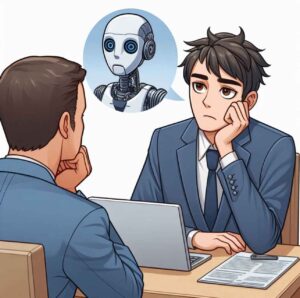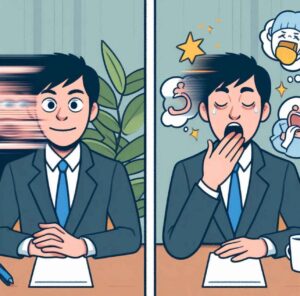Welcome Blessings!
(Tap 🔽 to see more topics!)


The opening act determines the whole show, and nowhere is more accurate than a job interview, where your self-introduction is that crucial first scene. When you’re asked to tell the interviewer about yourself, that little bit of time, it’s not just a casual chat. It’s the moment you start building the bridge to your potential future. Also, it is your chance to paint a vivid picture and show them who you are, what you bring, and why they need you.
But the reality is, there are so many good, qualified people who stumble right here. They get caught up in nerves, ramble, and accidentally say things that don’t click. It’s like trying to start a fire with wet wood—it just doesn’t catch. Most people have been there, that feeling of your heart pounding when they say, “Tell me about yourself.” It’s normal. But it doesn’t have to be a disaster.
Today, you will learn the seven most common, avoidable mistakes people make in their self-introduction and, more importantly, give you practical and easy tips to nail it. We’re talking about walking in, taking control of that moment, and leaving them thinking, “This is the person we’ve been looking for.”
(The “Information Dump)
Let’s imagine you’re at a party, and you meet someone new. If they start listing their entire life story — from kindergarten to the present — you’d probably start backing away slowly, right? The same happens in interviews when candidates must share too much in their self-introduction.
When you share too much information, the interviewers can get lost in the details and miss the key points. Remember, they have limited time and want to hear about your relevant skills and experience and why you’re the right fit for the role.
Keep it concise and relevant. Start with a brief professional summary, a sentence or two about your background and experience. Follow it up with the most pertinent accomplishments or skills that align with the job. It is like a teaser trailer for the rest of the interview, enough to spark interest but not give everything away. You’ll get more time to elaborate later.
“I’m a digital marketing professional with 5 years of experience specializing in social media strategy and content creation. I’ve helped brands grow their online presence and engagement by over 30%, and I’m excited to bring my expertise to this role.”
(The “Cookie-Cutter” Answer)

Imagine repeatedly walking into an interview and hearing the same answer to the self-introduction question: it’s predictable, dull, and doesn’t showcase your unique strengths. That’s precisely what happens when candidates rely on generic, one-size-fits-all responses.
Interviewers want to get to know you, not just hear a rehearsed, cookie-cutter answer. A generic response doesn’t highlight your personal touch or make you stand out from other candidates.
Instead of saying, “I’m a hard worker and a team player,” focus on what makes you unique. Share a specific achievement or experience that sets you apart from the crowd. This will help the interviewer see you as someone who adds value.
Instead of: “I‘m a hard-working individual who thrives in a team environment,”
Say: “I‘m someone who thrives when collaborating with diverse teams. For example, I led a team project where we developed a successful marketing campaign that increased customer retention by 25%. I find it fulfilling when everyone’s strengths come together to achieve great results.”
(The “Overshare”)
We all love a good personal story, but interviews are not the time for lengthy accounts of your weekend hobbies, relationships, or what you did last summer. Keeping your personal life in check is necessary unless it’s directly relevant to the role.
When you share personal details that don’t relate to the job, you can come across as unfocused or unprofessional. While being personable is great, interviews are about your professional qualifications.
Keep the focus on your professional background. Keep it short and relevant if you want to add a personal touch. For instance, mentioning a hobby that shows your creativity or teamwork can help, but ensure it doesn’t take too much time.
Instead of: “I love hiking, and I spend most of my free time traveling and exploring the outdoors.”
Say: “Outside of work, I enjoy hiking and traveling, which allows me to stay energized and creative. Spending time in nature helps me maintain a positive mindset and bring fresh perspectives to my work.”
(The “Me-First” Approach)
It’s easy to get wrapped up in selling yourself during an interview but remember, the interview is about how you can serve the company and fit into its culture. Focusing too much on your achievements without showing how you’ll add value can make you sound self-centered.
Interviewers are interested in how you can contribute to their organization’s goals. If your introduction revolves around “I, I, I,” it may leave the interviewer questioning how well you understand their needs.
While highlighting your strengths is important, connecting your experience with what the company needs is even more critical. Show them that you’re not just about what you can do but also what you can bring to their team.
Instead of: “I’ve won several awards for my leadership skills and have managed large teams.”
Say: “In my previous role, I managed a team that successfully executed a project that resulted in a 20% increase in sales. I’m excited about bringing this experience to your team and helping you achieve similar results.”
(The “Flat” Approach)

Interviews are nerve-wracking, but if you come across as disengaged or uninterested, it can hurt your chances. Enthusiasm is contagious, and showing a little energy can go a long way.
A lack of enthusiasm can be perceived as disinterest in the job, even if that’s not your intention. Hiring managers want someone qualified and passionate about the role.
Show genuine excitement about the opportunity. Speak with enthusiasm and positivity, and don’t be afraid to smile. If you genuinely connect with the role, it will naturally come through in your introduction.
Instead of: “I’ve worked in marketing for a few years and am now looking for a new opportunity.”
Say: “I’m excited about this role because it aligns perfectly with my experience in digital marketing. I’ve been following your company’s innovative campaigns and would love the opportunity to contribute to your continued success.”
(The “Rushed or Dragged” Delivery)
How you deliver your self-introduction matters just as much as what you say. Speaking too fast can make you seem nervous or unprepared. While speaking too slowly can make you feel unsure or disconnected.
Speed affects how your message is received. If you speak too fast, you might come off as anxious. If you speak too slowly, you might seem unprepared or unsure.
Find a natural pace. Take a deep breath before speaking, and give yourself time to articulate your thoughts clearly. Speak confidently but not hurriedly. The key is to sound conversational and relaxed.
Instead of rushing through your introduction:
“I’m a product manager with 7 years of experience in software development…”
Slow it down to:
“I’m a product manager, and I’ve spent 7 years leading teams in software development, helping to launch multiple successful products.”

(The “One-Size-Fits-All” Approach)
You’ve got the perfect introduction ready for an interview, and then you realize you’re saying the same thing for every job interview. However, not tailoring your self-introduction to the specific role and company is a huge mistake.
Failing to tailor your introduction makes you sound like you didn’t research or are applying for jobs at random. It doesn’t show you understand the company or how you can contribute to its mission.
Before the interview, take a few moments to research the company and the role. Use this information to adjust your introduction to align with the company’s values, goals, and the specific position you’re applying for.
Instead of: “I’m a marketing professional with 5 years of experience…”
Say: “I’ve been following your company’s growth in sustainable products, and I’m particularly excited about this role because of my experience in eco-friendly brand marketing. I’m confident that my skills can help further elevate your commitment to sustainability.”
Think of that initial ‘tell me about yourself’ moment as the warm handshake that opens the door to your next chapter. It’s more than just reciting your resume. But, it’s about showing the interviewers the real you—the person with the skills, the drive, and the perfect spark for their team. It’s your story, told in a way that shows how you fit into their world, and don’t be afraid to let your personality shine through. They’re not looking for a checklist. However, they’re looking for a person.
Keep in mind, too, that they aren’t just choosing you. It’s you choosing them. You’re deciding where you’ll spend a big chunk of your life. So, pay attention to the vibe. Is this an environment where you can grow and thrive? Remember, we’re all getting older, and job hopping isn’t a long-term solution! Don’t just chase a paycheck. Chase a place that nurtures your well-being.
That all starts with your self-introduction. Notice how they react. Are they genuinely engaged? How do the employees look? Tired? Stressed? Rushed, like they don’t even have time to brush their teeth or retouch their face? If they seem constantly drained, chances are, you’ll feel the same way if you join them. Your gut feeling is your best guide. If something feels off, it probably is.
Job interviews are a two-way street, a real conversation. Take a deep breath, be authentic, and let your passion shine through. And if you’re ready to fine-tune your interview presence even further, read more here. It’s packed with practical tips to help you make a lasting impression. Remember, it all starts with that self-introduction, that “tell me about yourself” moment… Good luck, and God bless!
Voila! Until next time!